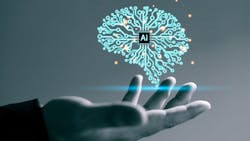How manufacturers can manage AI challenges
Consulting and services company Deloitte is working with manufacturing clients on generative AI (Gen AI) applications. Pilot projects are in infancy stages, but private large language models are showing the potential to draw insights from very large data sets. Industry is exploring its many opportunities with companies like Deloitte, where Tim Gaus, principal and smart manufacturing lead, helps manufacturers in the field and at its Smart Factory research facility in Wichita, KS. For more about the Smart Factory and current Gen AI application, read this article.
Gaus sees the most potential for Gen AI in its ability to index information that we’ve always had access to, but stored in a way that’s much easier to interact with. For example, Gaus predicts that in the near future, Gen AI will conduct the safety briefing on the plant floor, monitor quality defects in production, and provide a guided interaction to determine root causes of problems for operators. “I wouldn’t say we’re fully to where we want to be, but it’s an active area of innovation and investment for us right now,” Gaus says.
The secret to scaling AI
The ability to take solutions from one spot in the operation to another, while keeping implementation costs low, will help AI solutions scale, with the right core underlying data model, Gaus says.
“Foundational to AI is the availability of data, and very often the highest value and highest ROI solutions occur at the intersection of functional areas (for example, direct material quality connected to manufacturing efficiency). Thus, the rise of AI is driving the cleansing and alignment of data across organizational functions to enable richer and higher value insights,” Gaus adds. “In the past, those data domains and the accountability for outcomes have often existed within that individual function, but with the growth of AI it’s become critical to break down those organizational and data barriers.”
The use of AI is prevalent across the manufacturing supply chain, not just end users, Gaus says. Equipment and software developers, system integrators, raw material producers, and logistics delivering materials and end products and more are all using AI and machine learning to enhance decision-making processes.
“I think about this connection spanning the full value chain from product design through to end customers and consumers. The power of AI increases the collaborative application of insights that flow from a connected digital thread. The list above captures the folks with direct connection to the physical product. But in this case, the initial design and then subsequent updates to the product, the ability to forecast the demand for that product, and ongoing service, if applicable, of that product when in the field would be part of that connected value chain,” Gaus says.
This type of system also needs the right controls and security, but Gaus says, it presents an interesting operations model shift with innovative uses of AI. “I personally believe it's going to start to break down some of the previously strong silos that have sat between manufacturing and a broader end to end supply chain, because we're not constrained on where we're consuming information from and also not restricted and who has access to that information,” he adds.
It's difficult to predict how quickly Gen AI will become manufacturing’s true partner, but Deloitte has multiple clients with pilot projects in place. “The adoption curve will be defined more by how quickly manufacturers can drive a direct ROI on the investments,” Gaus says.
Risks for manufacturers: gaining trust and ROI
Gen AI applications in manufacturing do not come without some risk, as the large language models that power these applications are entirely dependent on the information provided to guide their models. “What is an expert? becomes very important,” Gaus says.
Private companies are typically using smaller large language models that are not manufacturing specific; that knowledge comes entirely from the information that’s loaded in for contextualization. “They are getting their own private access to develop large language models, which are just smaller in size, but really quite fit for purpose for all the use cases that we currently see today,” he adds.
The use of large language models can be expensive, but manufacturers will likely not be building from scratch, so capex can be minimized. “Energy and money can be put where the ROI can be directly measured. The analogy of cloud consumption costs would be very applicable for how to think about Gen AI, where clients will have a ‘per transaction’ cost, rather than comparison against tradition capital investment,” he adds.
A big deterrent for AI in manufacturing is the trust factor. “One of the big downfalls of pure AI is explain-ability,” Gaus says. “People don’t have confidence because it’s a quote/unquote black box, and so they don’t want to trust the outcomes.”
However, Gen AI in combination with the AI analytics gives users access to a level of interrogation that is more human-like, which can help users better understand and trust the technology. Gen AI will be able to explain and answer questions for users, who can probe and question further. “I think it demystifies what AI has been doing all along,” Gaus says. “I think we’re solving very human things using very advanced techniques.”
Many Deloitte clients also have yet to fully figure out the true value proposition versus the cool factor, Gaus says. “I firmly believe there’s a very strong value proposition, but there’s also a cost for this and finding that balance is going to be really important” for plants.
About the Author

Anna Townshend
managing editor
Anna Townshend has been a journalist and editor for almost 20 years. She joined Control Design and Plant Services as managing editor in June 2020. Previously, for more than 10 years, she was the editor of Marina Dock Age and International Dredging Review. In addition to writing and editing thousands of articles in her career, she has been an active speaker on industry panels and presentations, as well as host for the Tool Belt and Control Intelligence podcasts. Email her at [email protected].
